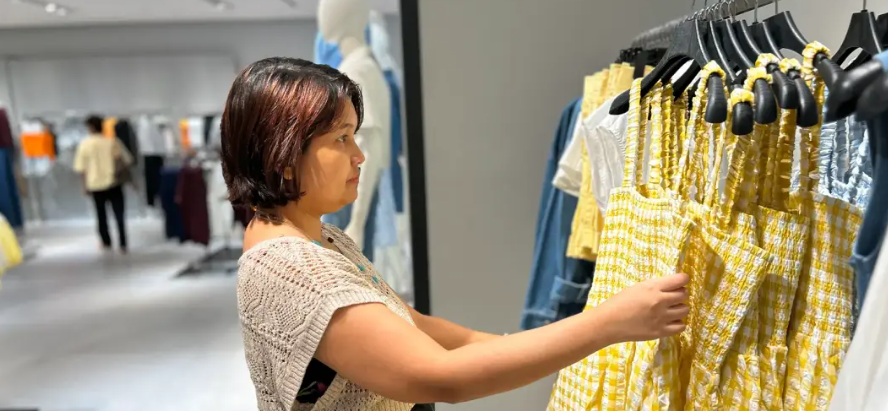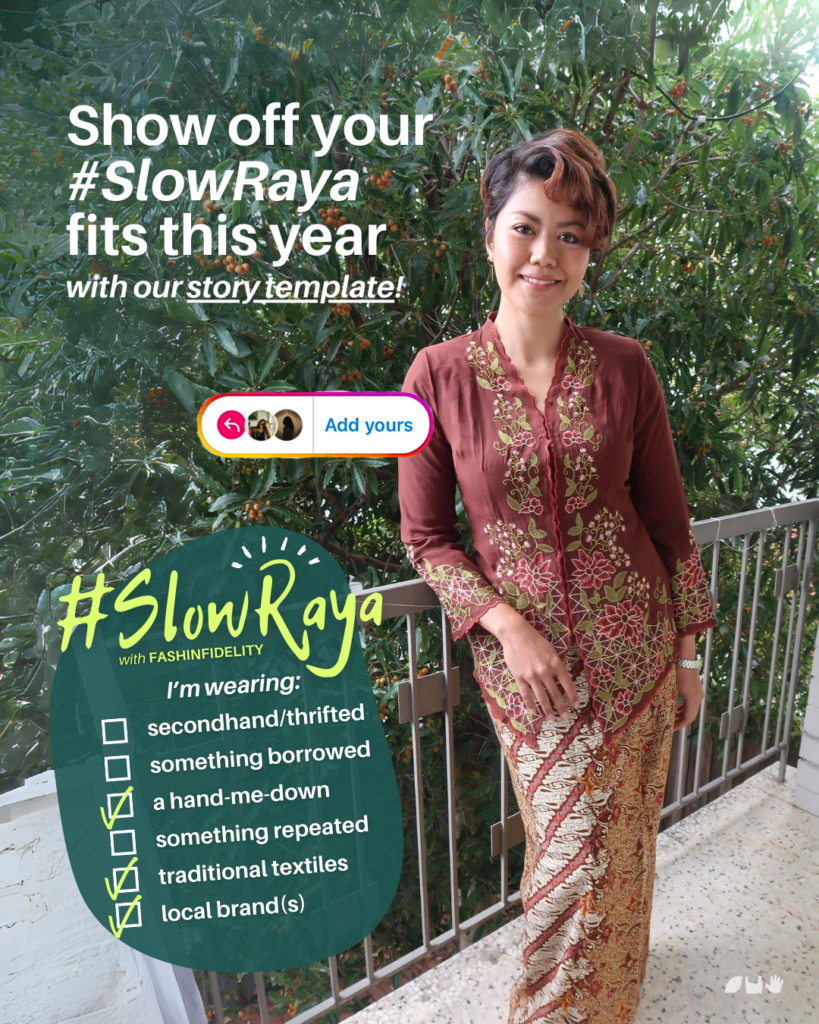This is Author Dayana Sobri’s powerful story on mental health, recovery, and slow fashion.
At FASHINFIDELITY, we’ve long believed that conversations around mental health deserve more visibility—especially within the world of fashion, consumerism, and content creation. Enter Dayana Sobri, author of Torn Between Desires: Exploring the Depths of Mental Health and Compulsive Shopping, a book that explores the often-overlooked intersection between mental health and shopping behaviours. Her book—launched in November 2024 alongside a forum of respected local mental health and personal finance professionals—dives deep into how consumer culture, often glamorised in fashion and media, can intersect with mental health challenges in ways we rarely talk about. In honour of Mental Health Awareness Month, we sat down with Dayana to learn more about the motivations behind her work, why sharing mental health stories matters, and how both individuals and industries can create space for healing, reflection, and change.
Q: What inspired you to write Torn Between Desires?
Growing up, I was an unpopular, ugly, socially inept, and mediocre girl who went through traumatising events like sexual harassment and bullying. I didn’t know how to seek help so I just bottled them up. This led to me being unable to achieve academically, hence my constant feelings of inadequacy and insecurity.
So to cope, I would buy quirky designer brands like Lulu Guinness or go to private sample sales events just to find unique pieces to impress my schoolmates. I thought maybe that way I would be more popular and accepted. This made me a dopamine-chasing shopaholic where I would go through episodes of highs and lows of buying pretty clothes and bags I didn’t really need.
Back then, mental health was still a taboo thing to talk about. I had two uncles who have mental health issues themselves so I thought maybe memang dah nasib I macam ni. I wasn’t sure whether it’s genetic or a coincidence that there are three people on my maternal side of the family who suffer from mental health issues.
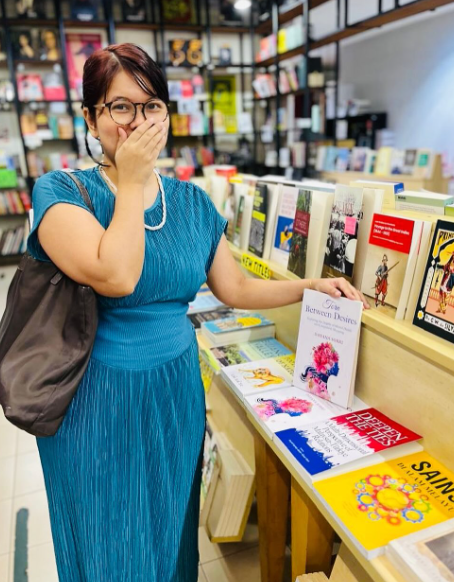
Dayana Sobri’s book “Torn Between Desires” was published by GerakBudaya, a Malaysian-based book distributor
Then I found a book about mental disorders and their link to addictions. I thought I had a shopping addiction due to untreated anxiety disorder and depression caused by my unresolved traumas. My suspicion came true when I was finally officially diagnosed with anxiety disorder and major depressive disorder in 2020 at Hospital Serdang.
I still find it hard to open up to my psychiatrist; not because I was ashamed of telling my stories, but that I had a hard time getting my thoughts together and stringing proper sentences on the spot. So instead of talking about it, I wrote down everything that had been plaguing my mind and stopping me from living my life to the fullest.
I didn’t even plan on having my book published or becoming an author. I just suka-suka hantar my manuscript and synopsis to GerakBudaya, expecting to receive feedback on my writing. Surprisingly less than two hours later, one of the publishing house’s executives contacted me, saying they’re interested in publishing my book.
Q: What was your “turning point” or “aha moment” that shifted your relationship with emotional spending?
I realised I had a serious problem when I reached a point where I would rather buy a vintage 1980s YSL brocade dress that costs thousands of Ringgit instead of paying for my medical bills (unrelated to my mental health issues) just to feel worthy and happy. It opened my eyes to how low my self-esteem was and how badly I see myself.
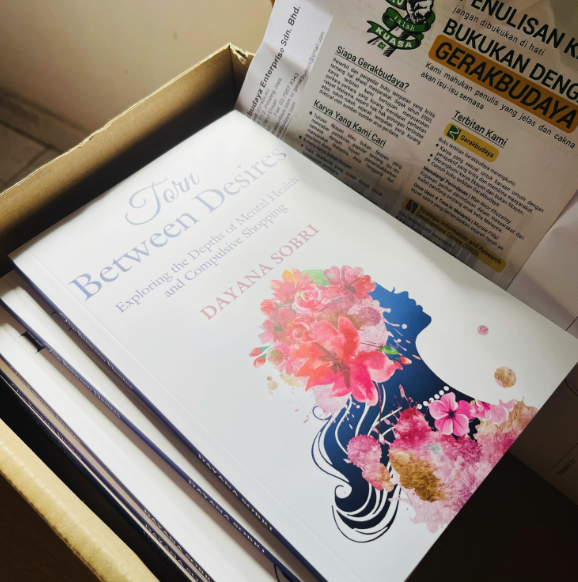
Q: From your research and personal understanding, what are some reasons/common unmet needs that led people to shop compulsively?
From my research and understanding, people often shop compulsively to fill emotional voids—like loneliness, stress, or low self-esteem.
It becomes a quick escape or a way to feel control, validation, or instant gratification, especially when deeper needs like connection, purpose, or self-worth aren’t being met. I can’t speak for everyone but all of these are true in my case.
Q: Were there particular items or types of shopping experiences that you felt most drawn to when you were struggling emotionally? Why do you think that was?
Yes, I was most drawn to buying clothes, bags, and accessories—things that made me feel more confident or like I was improving myself. I think it was because they offered a sense of transformation and control when everything else felt uncertain or overwhelming.
Q: How do you think modern consumer culture makes it even harder for people struggling with mental health issues to resist emotional spending? Are there any marketing tactics, trends, or messages you feel are particularly harmful?
Modern consumer culture constantly pushes the idea that buying something will make you happier, more successful, or more lovable. When you’re already feeling low, those messages hit harder.
I think tactics like limited-time offers, influencer promotions, and hyper-targeted ads are especially harmful—they create urgency and FOMO, making it harder to pause and reflect before spending. The worst part is how easy and instant online shopping is now—it feels like a quick fix, even though it’s not.
Q: You explore the idea of “healthy indulgence” vs “destructive behaviour” – how can someone tell when they’ve crossed that line?
For me, the line gets crossed when the shopping isn’t about joy anymore—it’s about numbing, escaping, or trying to fill a void. If I feel guilt right after, if I’m hiding purchases, or if it’s hurting my finances or mental health, that’s when I know it’s no longer healthy indulgence—it’s become something destructive.
THAT vintage 1980s YSL brocade dress
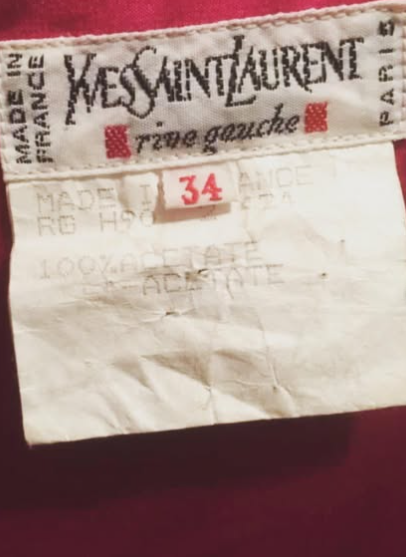
Q: For someone starting to realise that their shopping habits may be tied to emotional struggles, what’s the first step you would encourage them to take?
The first step I’d encourage is to simply pause and get curious about what’s driving the urge to shop. Before reaching for your phone or wallet, take a moment to ask yourself: What am I really feeling right now? Is it stress, boredom, sadness, loneliness, or even just the need for a quick boost of joy or control? Naming the emotion can be incredibly powerful—it creates space between the feeling and the action, which is often the first step toward changing a pattern.
From there, I’d recommend journaling your thoughts or talking to someone you trust. You don’t need to fix everything right away, but giving yourself the chance to reflect on what’s underneath the habit is key. It’s not about shaming yourself for the behavior—it’s about gently understanding the emotional roots of it. That self-awareness is what helps you start making more intentional choices, and eventually, find healthier ways to meet your emotional needs.
Q: How did your support system (family, friends, therapy, etc) help you on your journey toward healing? How do you think loved ones can best support someone struggling with compulsive buying?
Having a support system made all the difference—therapy helped me understand the root of my behaviour, and my husband and sister listened without judgment and reminded me I wasn’t alone. I think the best way loved ones can help is by being patient, creating a safe space to talk, and encouraging professional help without shaming or trying to control.
How has your relationship with shopping and with yourself evolved since writing this book? (you can touch on the positive changes you’ve seen in yourself + your involvement with slow fashion here if you’d like!)
Since writing this book, my relationship with shopping—and with myself—has changed in really meaningful ways. I’ve become more open about my struggles, which has helped me let go of a lot of the shame I used to carry. I’m also much more frugal now; I no longer use shopping as a coping mechanism, and I’ve become more intentional about what I bring into my life.
One of the biggest shifts has been learning about the environmental and ethical impact of fast fashion. It opened my eyes to how much harm mindless shopping can cause—not just to my wallet or mental health, but to the planet and the people making these products. That’s what led me to embrace slow fashion.
Now, I only shop thrift, and I take pride in choosing secondhand or sustainable pieces. It’s helped me reconnect with my values and feel more aligned with the kind of person I want to be: mindful, conscious, and compassionate. But even better than thrift shopping is joining clothes swapping events! I get to connect with other swappers and share my stories.
Additionally, after I watched the heartbreaking document, The True Cost, I honestly couldn’t bear to step foot in fast fashion stores. If I did, every piece on the rack that I touched and looked closely just reminded me of the horrors of the Rana Plaza victims, especially for items with the tag ‘’Made in Bangladesh.’’ I would wonder if a barely eight year old child working long hours in an unsafe environment for low wages was the one who made the clothes?

Q: What do you hope readers ultimately take away from Torn Between Desires?
I hope readers come away from Torn Between Desires feeling seen, less alone, and more empowered to face their own struggles with honesty and compassion. For me, this book isn’t just about shopping—it’s about what drives us to seek comfort or validation in things, and how we can learn to rewrite that pattern with self-awareness and care.
I want readers to understand that emotional spending isn’t a sign of weakness—it’s often a response to deeper unmet needs. By sharing my own journey, I hope to open up conversations around mental health, self-worth, and the pressure to consume in a world that constantly tells us we’re not enough. Most of all, I want people to know that change is possible. With support, reflection, and intention, we can all learn to find joy, comfort, and identity in ways that are truly sustainable—both for ourselves and the world around us.
Thank you Dayana for sharing your story. We hope to encourage open conversations, validate lived experiences, and inspire action—whether in personal healing or in shaping healthier, more humane industry practices from your personal insights and professional reflections.
May is Mental Health Awareness Month
May is Mental Health Awareness Month—a time dedicated to raising awareness, breaking stigma, and encouraging open conversations about mental well-being. First observed in the United States in 1949 and now recognised globally, this month serves as a reminder that mental health is just as important as physical health. It’s an opportunity for individuals, communities, and organisations to highlight the importance of mental health education, access to care, and supportive environments—especially in a world where burnout, anxiety, and emotional stress are on the rise.
Fashion isn’t just about what we wear—it deeply affects our mental well-being. As the supply chain continues to strain under relentless demands, so too do the people powering it—from brand founders and creatives to factory workers and retail staff. FASHINFIDELITY has never shied away from the realities of this industry. We have in the past explored topics such as pressures of fashion school, the toll of social media trends, and how the industry’s fast-paced, image-driven culture can harm mental health. From cancel culture moments to personal stories and expert insights, our discussions has shed light on the emotional challenges faced by designers, students, and consumers alike.
We will be featuring more fashion and #mentalhealth stories throughout the month on our socials, including a forum with panellists sharing their take and mental health challenges, so make sure to follow us on Facebook and Instagram for the latest! We believe having these conversations out loud and addressing these issues collectively can foster a healthier, more mindful relationship with fashion—one that empowers rather than overwhelms.
We hope you’ve enjoyed this conversation with Dayana, and, if you can, please help purchase a copy of her book from GerakBudaya, Ilham Books, or Popular Online.

